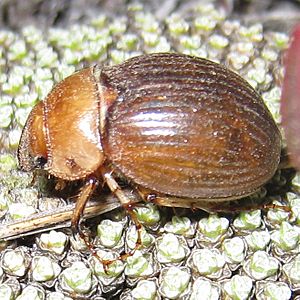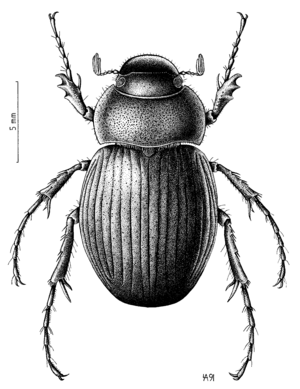Cromwell chafer beetle facts for kids
Quick facts for kids Cromwell chafer beetle |
|
|---|---|
 |
|
| Conservation status | |
 Nationally Endangered (NZ TCS) |
|
| Scientific classification | |
| Kingdom: | |
| Phylum: | |
| Class: | |
| Order: | |
| Family: | |
| Genus: |
Prodontria
|
| Species: |
P. lewisii
|
| Binomial name | |
| Prodontria lewisii Broun, 1904
|
|
| Synonyms | |
|
Prodontria lewisi |
|
The Cromwell chafer beetle (Prodontria lewisii) is a special type of beetle that cannot fly. It belongs to the Scarabaeidae family, which includes many kinds of beetles. This unique beetle lives in only one small area in Central Otago, New Zealand. This area is now a special nature reserve created just for these beetles.
About the Cromwell Chafer Beetle
This beetle was first named by a scientist called Broun in 1904. He found three of these beetles on the sand-hills near the Molyneaux River. He named the species Prodontria lewisii after Mr. J. H. Lewis, who found them.
This is a large beetle. It has pale reddish-brown elytra, which are its hard wing covers. These covers are very rounded and have deep grooves along their length. Female beetles are usually longer and wider than males. However, male beetles have longer back feet and lower leg sections (called tibias).
These beetles spend most of their lives underground. They live for at least one year as larvae, which are like grubs. The larvae stay buried in the sand and eat plant roots. Adult beetles come out of the ground on warm, humid nights during spring and summer. They only come out for a few hours. During this time, they feed on small plants like lichens, speedwell, sheep's sorrel, and cushion plants. They also mate during these brief appearances. Males usually emerge a little earlier in the year than females.
Where They Live
The Cromwell chafer beetle lives in an area of low sand dunes. This area is on a river terrace near Cromwell, and it's known as the “Cromwell shallow sand”. These sand dunes were formed from fine dust called loess, which was carried by the Clutha River. The Cromwell chafer beetle is very good at burrowing in these inland sand dunes. Because of this, its natural home was probably never bigger than about 500 hectares (which is about 1,235 acres).
Today, the beetle only lives in an 81-hectare nature reserve. This reserve is located between Bannockburn and Cromwell. Scientists regularly check on the beetles. Their surveys show that the beetles are only using about 12% of the available habitat within the reserve.
Protecting the Beetles
The area where these beetles live is also where the town of Cromwell is located. In 1968, some beetles were found north of the town, next to a golf course. However, that group of beetles disappeared when the golf course was made bigger. In the 1970s, there was still a block of undeveloped land in Cromwell town itself. Two local people used special traps to catch and move the beetles from this area in 1975–76. This was done before the land was cleared for new houses.
Much of the beetle's original home was lost when the Clyde Dam was built in 1979. This dam created Lake Dunstan, which covered many areas where the beetles used to live.
The last remaining group of Cromwell chafers was in a 95-hectare area just south-west of Cromwell. In 1979, an 81-hectare part of this land was fenced off to protect the beetles. In 1983, it officially became the Cromwell Chafer Beetle Nature Reserve. At that time, it was the only reserve in the world created just for an invertebrate (an animal without a backbone).
In 1996, the Cromwell chafer was listed as Critically Endangered on the IUCN Red List. This means it faces a very high risk of disappearing forever. The New Zealand Department of Conservation also lists it as Nationally Endangered. In the past, losing their habitat was the biggest threat. Now, the main danger comes from animals that have been brought to New Zealand from other places.
The beetles are hunted by introduced hedgehogs, little owls, and possibly European earwigs. Recently, the Australian redback spider has become a big concern. These spiders arrived in Central Otago in the 1980s. Redback spiders hide in rabbit holes in the reserve. They might kill hundreds of chafer beetles each year. The Department of Conservation is working to control rabbits and destroy their burrows in the reserve. This helps protect the beetles.
Every year, there is a survey to count the Cromwell chafer beetles. This event is sometimes called "Cromwell chafer beetle day." Scientists from the DOC and Agresearch take 670 core samples of sand from the reserve. They check these samples for beetle larvae. Usually, they find very few individuals in each survey. The total number of Cromwell chafers alive today is thought to be around 3000 beetles.





